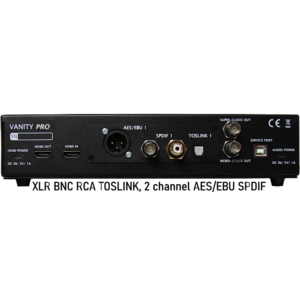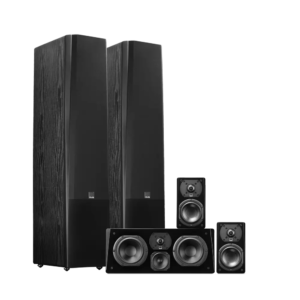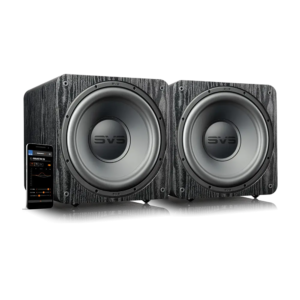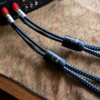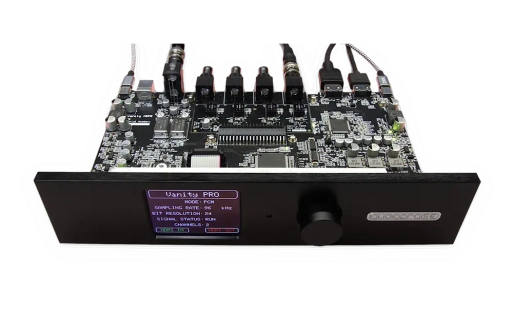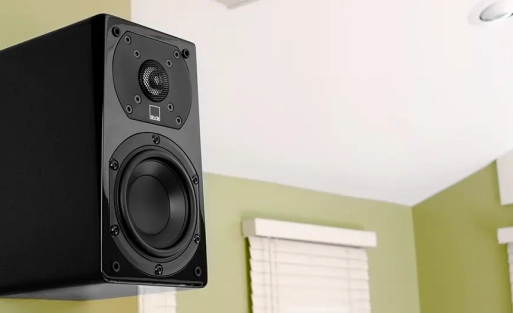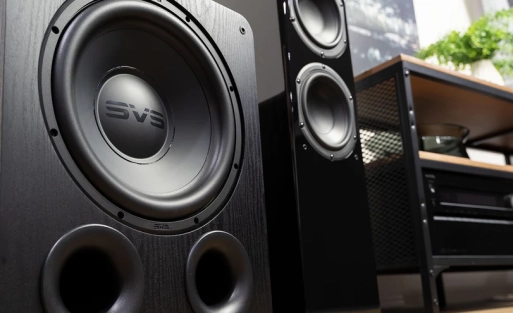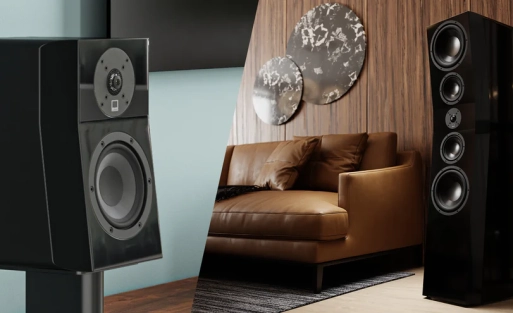No products in the cart.
Return To Shop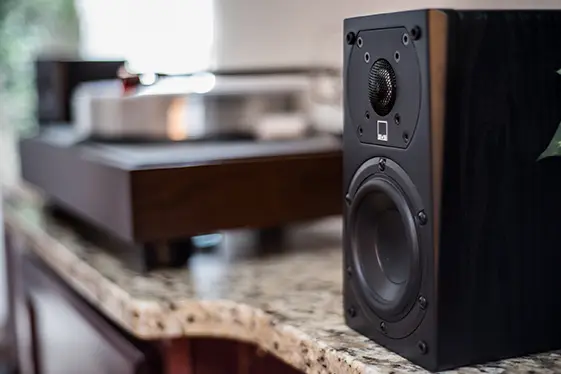
The magic of 2-channel stereo systems
While soundbars, Bluetooth speakers and surround sound for home theaters get the most attention these days, 2-channel stereo speaker systems have been around much longer and continue to be used by a diverse and often discriminating audience. In this article, we take a closer look at what makes 2-channel systems so special, choose the best speakers, give placement tips and how to make them sound as good as possible.
Sound and imaging: The magic of 2-channel stereo systems
The term “stereo” is usually used for 2-channel speaker systems with only left and right front speaker channels. When a pair of speakers are properly designed and set up, they produce a three-dimensional sound image that is generally described by two words: soundstage and imaging.
Speakers can only create a good soundstage and image if they have an accurate frequency response, because accuracy creates synchronization, which is essential for reproducing a rock-solid stereo image. Speakers must not only be true to the source material in terms of tonal accuracy, the drivers and crossovers must also play in perfect harmony with each other to give the illusion of a seamless soundstage without gaps. All SVS speakers are carefully designed to accurately and naturally reproduce instruments, voices and all sounds. Without precise accuracy, the soundstage can appear distorted and the location of voices and instruments can seem jumbled.
“Sound image” refers to the sense of space in the sound. Of course, there is a sense of space directly between the two speakers; when a sound is played through both speakers, it seems to come from somewhere. But well designed and placed speakers create a sense of depth, where some sounds seem to be closer to you while others are farther away. The best active stereo speaker systems can even create a soundstage wider than the physical locations of the speakers, so you hear sound coming from the sides, behind and even above.
“Imaging” refers to the ability of a pair of stereo speakers to reproduce different sounds as if they came from specific locations within the soundstage. For example, you can hear a singer right in front of you, while the drum beat comes from behind the singer. The better the home stereo speakers, the more precise and accurate their reproduction, and this is part of the “magic” of listening to music through great speakers.
Tips for stereo speaker placement
Apart from the speaker’s inherent capabilities in terms of sound image and imaging, placement and room demarcation are important factors to consider when setting up a stereo pair of speakers. Let’s start with the listener. Ideally, the center of each speaker should form an equilateral triangle with the listener’s head, and the speakers should make a slight angle – “tilted inward” – to face the listener directly. Also, the tweeters should be at the same height as the listener’s ears.
In any stereo system, there is a “sweet spot” where you hear the best possible soundstage and imaging that the speakers can create. If you like to listen with friends and family, you probably have a couch or several chairs in your listening room and as long as they are close to the center between the speakers, it will sound great. Speakers such as the SVS Prime and Ultra Series have features such as angled front baffles, FEA-optimized tweeter diffusers and other innovations to ensure the widest possible sweet spot.
Next, consider the space. If possible, a pair of stereo speakers should be free standing at least 6 inches from all walls, with a little room to “breathe.” This space helps to open up the soundstage and bring the image into better focus. Knowing this, there are several options to consider when choosing the best speakers for your room, as we will discuss in the next section.
Tower or bookshelf stereo speakers?
A question we often get is whether floorstanding tower speakers or bookshelf speakers work best for a home stereo system. It depends on several factors, including the size of the room and the budget.
Tower speakers are generally recommended in larger rooms because they can produce larger output levels thanks to larger cabinets and more drivers. Bookshelf speakers are often a better choice in small rooms where you stand relatively close to the speakers.
As their name suggests, bookshelf speakers can be placed in a bookcase. But this is usually not a good idea because the proximity within the bookshelf can affect the sound of the speaker, especially if it is a rear ported design. It is generally better to place bookshelf speakers on stands away from the wall, or on top of an AV cabinet or other piece of furniture where they are not enclosed. Interestingly, because of their vertical orientation, tower speakers can take up less space than bookshelf speakers on stands.
Another consideration is that bookshelf speakers typically don’t have as much deep bass as tower speakers, so you may want to consider a powered subwoofer to your stereo system if you choose this route. (Adding a subwoofer to a tower-based system is not a bad idea either!) Of course, that means finding room for a subwoofer in the room. And if there is room enough go for dual subwoofers, read about that in this blog: Why dual subwoofers?
In terms of budget, bookshelf speakers are usually cheaper than towers. But that advantage can be negated if you add the cost of a subwoofer.
Wired or wireless stereo speakers?
There are numerous options when it comes to powering a pair of speakers. AV receivers are the most common source of power and audio signal transmission and include a large number of inputs/outputs for both 2-channel stereo and home theater surround sound systems. Most major brand options are relatively affordable and sound great to most people.
The very best 2-channel high-end speaker systems use a separate stereo preamplifier and stereo power amplifier that focus entirely on delivering pure, effortless power and pristine sound reproduction. There is no denying that these systems sound the best, but they can also get shockingly expensive and offer diminishing returns when you reach a certain point.
Increasingly popular are modern wireless integrated stereo amplifiers , such as the SVS Prime Wireless Pro SoundBase, which can be connected to existing passive speakers. These components feature wireless streaming capabilities from your smartphone or other devices, powerful DACs and ample power to drive speakers optimally. They often have dedicated subwoofer output and other inputs for connectivity to multiple devices. In this case, connecting to your stereo speakers is as easy as plug-n-play and you have all your music at your fingertips.
One of the most popular solutions for people who want a quick, affordable and easy setup are wireless Bluetooth stereo speakers , such as the SVS Prime Wireless Pro Powered Speaker Pair. These speakers are the ultimate in convenience because they are self-powered, so they don’t need a separate receiver or power amplifier needed, and they avoid the mess of speaker cables .
Some portable Bluetooth speakers run on batteries, but if you are looking for the best sounding wireless stereo speaker system, it is important to focus on speakers that can be plugged into a wall outlet and have WiFi as a streaming option. WiFi speakers have more bandwidth and allow you to stream in full high resolution, something only Bluetooth speakers cannot provide. This means deeper and more powerful bass, improved dynamics, detailed clarity and the ability to play loud without distortion. Overall, a better overall listening experience.
Just pair them with your smartphone or other device and you can start streaming music right away. There are several streaming sources with high-quality music, such as Qobuz, Amazon Music HD and Tidal’s Master library, but they require a monthly subscription. You can also stream music from a library you’ve compiled on a local storage device, such as an R_volution NAS .
Summary
With a rush toward the simplicity of soundbars and more and more channels in home theater systems, many audio fans have forgotten the simple pleasure of stereo speakers. After all, most music is still released in stereo format and we recommend listening to it as the artist did when he recorded and mixed it – with stereo speakers. If you follow the tips presented here, you will discover the magic of stereo speaker systems.
Do you have questions about something you just read? Call or email us and we will reply as soon as possible.
This is a loose copy of the original English SVS article, “The Magic of 2-Channel Stereo Speaker Systems.”
Also check out these popular products
SVS Prime Tower Surround System
From: € 2.229,00Select options This product has multiple variants. The options may be chosen on the product pageSVS Prime Wireless Pro Powered Speaker (set of 2)
€ 999,00Select options This product has multiple variants. The options may be chosen on the product pageSVS SB-1000 PRO (set of 2)
From: € 1.423,00Select options This product has multiple variants. The options may be chosen on the product pageTags: Explanation





